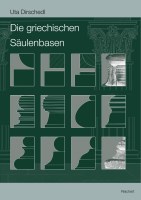Search
Die griechischen Säulenbasen
2013
21.0 x 29.7 cm, 652 p., 31 illustrations, 35 line drawings b/w, 40 diagrams, 529 illustrations b/w, 77 Tafeln mit 529 s/w-Abb., 4 Falttafeln, 31 Beilagen, 40 Diagramme, hardback
ISBN: 9783895009501
21.0 x 29.7 cm, 652 p., 31 illustrations, 35 line drawings b/w, 40 diagrams, 529 illustrations b/w, 77 Tafeln mit 529 s/w-Abb., 4 Falttafeln, 31 Beilagen, 40 Diagramme, hardback
98,00 €
ISBN: 9783895009501
Short Description
The column bases of about 460 Greek monuments from (proto)geometric to late Hellenistic times in the Greek home territory and on the Peloponnese, the Greek islands and in Asia minor, as well as examples from Greek colonies of the Magna Graecia and others, are covered. Twelve different types of Greek column, some variants and modifications and a few special forms can be distinguished. The different types were studied for their distribution, choice of materials, combination with forms of columns and building styles, form, fluting or decoration, proprotions, dating, origin, derivation, stone carving and technique; the results are summarised in a synopsis spanning all the different forms. The “foot” of the Ionian or Corinthian column, in contrast to the shaft and the capital, provided room for creative design; the individually formed types of column bases with a particular area of distribution were used as a characteristic form of expression for local architectural traditions.Description
The subject of the present study is the Greek column base – the “foot” of the Ionian column, whose architectural shape evolved from the early first millenium B.C. up to the late Hellenistic era.The column bases of about 460 different Greek monuments from (proto)geometric to late Hellenistic times – spanning a period of more than 900 years – in the Greek home territory and on the Peloponnese, the Greek islands and in Asia minor, as well as examples from Greek colonies in southern Italy and Sicily, the Black Sea region and the Nile Delta, are covered. Landmarks of Hellenistic cantral and southern Italian, Ptolemaic and Punic architecture with Greek column bases were also included in the study, as well as some isolated remnants of the Hellenistic world’s Eastern periphery.
Twelve different types of Greek column bases, some variants and modifications and a few special forms can be distinguished and, in part, classified in a new way. The different forms were studied for their distribution, choice of materials, combination with forms of columns and building styles, forms, fluting or decoration, proprotions, dating, origin, derivation, stone carving and technique; the results are summarised in a synopsis spanning all the different forms.
The analysis of the column bases shows, among other things, that the “foot” of the Ionian or Corinthian column , in contrast to the shaft and the capital, provided room for creative design, and the various individually formed types of column base with a particular area of distribution were apparently used as a characteristic form of expression for local architectural traditions. This is shown, for example, in the use of “exotic” Asia Minor column bases on monuments in temples with more than regional importance, such as the treasure houses of Clazonenae and Massalia, the Athenians’ Hall in Delphi or the Ptolemies’ votive offering in Olypmpia, which point to the origin of the founders, a place of military conflict or the home of the recipient. The conscious readoption of the Ionian-Carian tradition of the archaic Ephesian column bases in late classical buildings of the Carian Hecatomnidean dynasty in Labraunda and Halicarnassus after an interruption of roughly a century during the co-called Ionian remaissance also illustrates this.
The new designs of column bases at the temple of Nike on the Athenian Acropolis and the temple of Apollo in Bassai-Phigalia in the second half of the 5th century, which are influenced by the Ionian column bases, being independent “Attic” or “Peloponnesian” types of bases, are also motivated by the need to assimilate the Ionian column as received in Attica and on the Peloponnese using individual local base types.
Biographical Note
Dr Uta Dirschedl (*1968)Studied classical archaelogy, art history and ancient history at the University of Regensburg (and Würzburg)
2003 Ph.D., supervised by Prof. Burkhardt Wesenberg at the Chair for Classical Archaeology at the University of Regensburg, with her dissertation “Typology of Greek Column Bases”
2003/2004 Wülfing travel grant of the German Archaeological Institute (DAI)
2004/2005 Advanced training grant of the DAI
2005-2013 Academic consultant/head of the schloars‘ archive at the DAI’s main office in Berlin
Research projects:
2003-2013 “The archaic temple of Apollo (temple II) in Didyma”
since 2011 with Dr Andreas Oettel “The city walls of Lissus/Lezha in Albania”




 Preface
Preface

 Neuerscheinungen 2023/2024
Neuerscheinungen 2023/2024
 Gesamtverzeichnis 2023/2024
Gesamtverzeichnis 2023/2024
 Katalog Oriental Studies & Linguistics
Katalog Oriental Studies & Linguistics
 Mittelalter
Mittelalter
 Deutsche Inschriften
Deutsche Inschriften
 Musiktherapie
Musiktherapie
 Literaturen im Kontext
Literaturen im Kontext